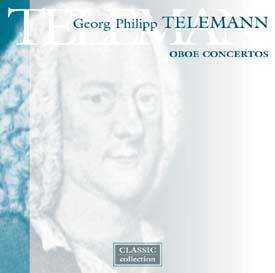Telemann wrote over a dozen concertos for solo
oboe or solo oboe d'amore and string orchestra. His writing for
the oboe is unfailingly rewarding, perhaps because of his own
fluency on the instrument. Though he acknowledged a certain proficiency
on the instrument if his writing is anything to go by he must
have been no mean performer himself. Generally the oboe concertos
are more interesting and more colourful than many of Telemann's
other single instrument concertos. Perhaps because there are so
relatively few of them, dull patches are rarer.
On this recording six concertos involving an
oboe are played by Thomas Indermühle, who also directs the
English Chamber Orchestra. Indermühle plays three oboe concertos,
two oboe d'amore concertos and is joined by two unnamed violinists
for a concerto for oboe and two violins. Indermühle is a
Swiss oboist who studied with Heinz Holliger and Maurice Bourgue,
spending several years as oboist with the Netherlands Chamber
Orchestra and the Rotterdam Philharmonic.
Indermühle's playing on this disc is most
enjoyable, always stylish and shapely. He never makes you aware
of the technical skill needed to play these tricky pieces. All
you have to do is sit back and enjoy it. And there is much to
enjoy. All the concertos on this disc follow the same pattern
of four movements alternating slow and fast movements. The slow
movements can mine that vein of melancholy at which the oboe is
so apt. The fast movements usually involve snappy rhythms with
many folk influences. Whereas Vivaldi's oboe concertos tend be
all cast in a similar style, Telemann never fails to amaze with
the variety of his imagination.
The E minor oboe concerto opens with a big string
ritornello and develops into a very Handelian Adagio. This is
followed by a furious, brilliant Allegro Molto in which Indermühle
only pauses for breath in the short, contrasting B section. The
Largo is a gracious movement, but the string accompaniment is
rather stodgy. This carries over into the Allegro final, which
is lively enough, but does lack sparkle.
This first movement of the D major concerto develops
into a winning Gratioso, which is an apt name for the whole concerto.
This movement leads into a rhythmic Allegro with an engaging galloping
movement in the strings. The second Adagio is another poetic,
melancholy movement. Unfortunately, in these performances the
final Allegro lets the performance down as it comes over as rather
too steady and ponderous.
The C minor oboe concerto opens with a sustained,
uncompromising dissonance and the solo oboe is supported by restless
strings. This haunting moment commands attention and your attention
never wavers through the 4 movements. A gentle Allegro, with a
rather pointed melody, follows and the simple second Adagio is
followed by an Allegro final where the more robust moments contrast
with quieter ones.
The D minor oboe concerto opens with another
melancholy Adagio, a very powerful one which is followed by an
infectious, perky Allegro. A short recitative leads to the lively
Allegro with its thematic material based on running figures.
Both of the Oboe d'amore concertos are immensely
seductive works. The A major concerto opens with a haunting Siciliano
with a theme that has a certain harmonic restlessness. This is
followed by a triumphant, showpiece aria-like movement. The Largo
opens with dark brooding string chords; when the oboe d'amore
enters it is accompanied just by the continuo instrument. The
finale, marked Vivace, is a folk-like country dance. The G major
concerto's opening movement is charmingly marked 'Soave' and is
a gracious, minuet-like dance movement which is followed by another
aria-like Allegro in which the soloist gets to display his facility
for passage-work in a series of dialogues with the strings. In
the Adagio, Indermühle spins beautiful, melancholic, long
slow lines over a walking bass. For the finale, the strings provide
another country-dance like figure over which the oboe d'amore
cascades decorations.
The performances from the English Chamber Orchestra
are responsive and generally stylish. Sometimes their bass lines
err on the side of heaviness, but that is a matter of taste …
and styles in Baroque performance are always evolving.
This is a highly recommendable disc. If the idea
of a whole disc devoted to oboe concertos by Telemann fills you
with foreboding, then do consider this delightful, highly infectious
disc.
Robert Hugill
